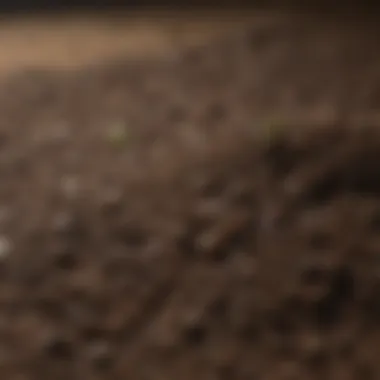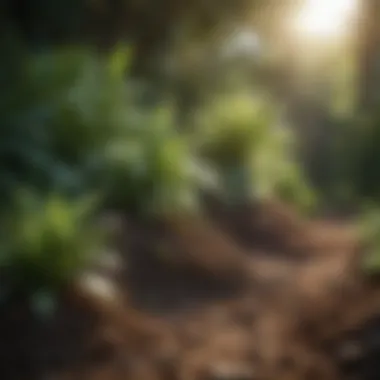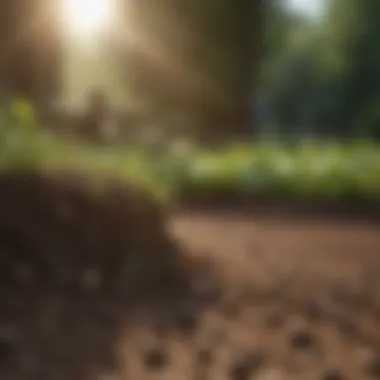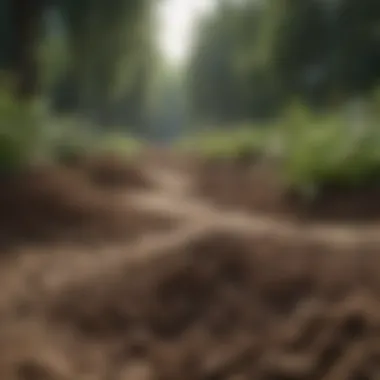Seeding Topsoil: Your Essential Guide to Success


Intro
Seeding topsoil plays a critical role in both gardening and landscaping. Understanding its composition and effective techniques of seeding is essential for achieving lush and healthy vegetation. Whether you are just starting your gardening journey or you are an experienced gardener, knowing how to manage topsoil can greatly impact the success of your plants. This guide explores the elements that contribute to successful topsoil seeding, practical advice for care and maintenance, and the vital role it plays in the environment.
Design Inspiration
The Importance of Soil in Design
While many may think of design as concerning aesthetics alone, the quality of the soil is fundamental in any landscaping project. High-quality topsoil not only promotes plant health but also influences the overall design of a garden or landscape. The interplay between soil and plant selection can elevate the beauty of any space.
Trends in Gardening Design
Current gardening trends lean towards natural aesthetics. Many homeowners are opting for native plants that require less maintenance and are more resilient to local climates. This shift not only enhances the ecological balance but also blends seamlessly into the landscape.
- Sustainable gardening: Practices like xeriscaping help conserve water while promoting native flora.
- Edible landscaping: Integrating edible plants into decorative gardens is gaining popularity, encouraging a functional approach to design.
Gardening Techniques
Effective Seeding Techniques
The success of seeding topsoil largely depends on several techniques, which include:
- Soil testing: Knowing the pH and nutrient levels will inform amendments.
- Layering: Applying organic matter like compost enriches topsoil and improves its texture.
- Proper seeding depth: Seeds should be planted at the right depth to ensure optimal germination.
Plant Selection and Care
Choosing the right plants enhances the effectiveness of your topsoil. Factors to consider include:
- Local climate: Select plants that thrive in your specific climate.
- Soil compatibility: Choose plants adapted to your soil type.
- Maintenance needs: Understand the care your chosen plants require to flourish.
Indoor vs. Outdoor Gardening
The approach to seeding can vary significantly depending on whether it is indoors or outdoors.
- Indoor gardening often requires specific soil mixes designed for container plants and a focus on light conditions.
- Outdoor gardening, on the other hand, may necessitate more extensive preparation and the use of topsoil amendments to support growth in various weather conditions.
"Proper management of topsoil significantly impacts plant health and environmental sustainability."
Understanding these techniques fosters a more effective gardening experience. In the chapters that follow, each aspect of seeding topsoil will be dissected further to provide readers with comprehensive insight.
Understanding Topsoil
Topsoil is a key element in the foundation of any healthy garden or landscape. It is the uppermost layer of soil, rich in nutrients, organic matter, and microorganisms that support plant life. The understanding of topsoil is crucial for anyone involved in gardening or landscaping. Without a firm grasp of what topsoil truly is, it becomes challenging to cultivate and maintain vibrant plants.
Defining Topsoil
Topsoil typically forms the top 2 to 8 inches of the earth's crust. It is a mixture of minerals, organic materials, air, and water. This layer is vital for plant growth because it contains the essential nutrients required for plants to thrive. Additionally, topsoil acts as a medium for water absorption and retention, which is critical for the survival of plants.
Topsoil is not uniform and can vary significantly based on geography and local conditions. Urban areas might have highly compacted soil, while rural or agricultural regions may offer richer, more loamy topsoils. Understanding this variability helps gardeners choose the right strategies for their specific environments.
The Role of Topsoil in Plant Growth
Topsoil serves multiple functions that are important for plant growth. First, it provides a habitat for the organisms that contribute to nutrient cycling, enhancing soil fertility. Secondly, it acts as a reservoir for water, allowing plants to access moisture needed for photosynthesis and other vital functions. Lastly, the root systems of plants anchor in topsoil, enabling stable growth.
Healthy topsoil promotes robust vegetation and can even improve resistance to disease and pest infestations. It supports a diverse range of microorganisms and insect life that contribute to nutrient cycling, ultimately benefitting the entire ecosystem.
Characteristics of Quality Topsoil
Not all topsoils are created equal. Quality topsoil possesses several key characteristics that define its health and functionality:
- Nutrient-Rich: A quality topsoil should contain a balance of primary nutrients such as nitrogen, phosphorus, and potassium, as well as secondary nutrients like calcium and magnesium.
- Good Texture: The texture should be well-balanced, often described as loamy, meaning it has a mix of sand, silt, and clay. This allows for optimal drainage while retaining moisture and nutrients.
- Organic Matter: High-quality topsoil contains a substantial portion of organic matter, which improves soil structure and promotes microbial activity.
- pH Balance: A suitable pH range is generally between 6.0 and 7.0, which is adequate for most plant species. Too acidic or alkaline topsoil could hinder nutrient availability.
By understanding these aspects of topsoil, one can make informed decisions that result in healthier gardens, optimized planting strategies, and sustainable practices.


The Importance of Seeding
Seeding is a foundational step in establishing a healthy garden or lawn. It involves placing seeds into the soil, giving life to new plants. This process is essential, as it determines the success of vegetation. Effective seeding can lead to lush greenery, while poor techniques may result in wasted effort and resources.
Why Seeding Matters
Seeding serves multiple purposes, which can hinge on various factors, including the region and the desired outcome. Firstly, it provides the right environment for plants to grow. Seeds help in beautifying outdoor spaces and enhancing air quality. When done successfully, seeding can lead to significant aesthetic and ecological benefits.
Additionally, healthy seeding practices contribute to the sustainability of gardens. Using native plant seeds, for example, encourages local wildlife and promotes biodiversity. This, in turn, creates self-sustaining ecosystems.
Moreover, seeding can also influence the overall productivity of a garden. Well-timed and well-placed seeds establish plants that yield better harvests. This is particularly important for homeowners keen on food production. Each season offers unique opportunities and careful consideration can maximize yields.
Seed Selection Criteria
Choosing the right seeds is crucial for successful seeding. Not all seeds are created equal, and several criteria should guide this selection:
- Suitability for Climate: Understand which plants thrive in your climate zone.
- Soil Compatibility: Different seeds require varying soil conditions. Knowing your topsoil's characteristics can help in making informed choices.
- Purpose of Planting: Whether for aesthetics, food production, or environmental restoration, plant goals determine seed choices.
- Growth Habit: Consider if plants will be annuals or perennials, their height, and spacing needs.
Choosing the right seeds not only leads to healthful growth but also enhances the overall aesthetic of the outdoor space. This carefully considered action ensures a vibrant, flourishing garden while respecting the nuances of the local ecosystem.
Remember: The right seed selection lays the groundwork for a successful gardening or landscaping project.
Preparing the Topsoil for Seeding
Preparing the topsoil is a crucial step before seeding. It sets the stage for successful plant growth. Well-prepared soil can increase seed germination rates and support healthy vegetation. This phase involves assessing the quality of the existing topsoil and making necessary amendments. Good preparation leads to better nutrient availability and moisture retention, which are vital for plants.
Testing Soil Quality
Testing the soil helps identify its strengths and weaknesses. This provides insight into how to enhance its quality for better plant growth. There are several key aspects to consider when testing soil.
pH Levels
pH levels indicate how acidic or alkaline the soil is. A pH between 6.0 and 7.5 is considered ideal for most plants. If the pH is too low or high, plants may struggle to absorb nutrients. Testing pH can guide adjustments that will optimize growing conditions. Knowing the pH level helps in choosing appropriate plants and amendments.
Nutrient Composition
Nutrient composition refers to the presence of essential elements like nitrogen, phosphorus, and potassium. These nutrients are critical for plant health. Conducting a nutrient analysis provides information on what is lacking in the soil. This allows gardeners to add fertilizers or amendments that can improve nutrient levels. Proper nutrient composition avoids deficiencies that may hinder plant growth.
Texture and Drainage
Soil texture affects how well it retains moisture and drains excess water. Sandy soils drain quickly but may not hold nutrients. Clay soils retain water but can become compacted. A good balance is essential for optimal growth. Testing texture helps determine if amendments are needed to improve drainage and water retention. Proper texture ensures that roots can access the moisture they need without risk of drowning.
Amending Topsoil
Amending topsoil involves enhancing its properties to improve overall soil quality. It is essential for creating a favorable environment for planting. There are various ways to amend topsoil.
Adding Organic Matter
Adding organic matter, such as compost or well-rotted manure, enriches the soil. It improves soil structure and increases nutrient availability. Organic matter also enhances moisture retention and encourages beneficial microorganisms. This is beneficial for long-term soil health and fertility.
Adjusting Soil pH
If soil pH is not in the ideal range, it can be adjusted. Adding lime can raise the pH, while sulfur can lower it. Adjusting soil pH is vital because it directly affects nutrient availability. It allows plants to access the essential elements they need to thrive. Considerations must be made on the type of soil and the plants being grown.
Improving Drainage
Improving drainage is key in preventing waterlogged conditions. Mixing in sand or organic materials can help clay soils drain better. Proper drainage is essential for root health; stagnant water can lead to diseases. Understanding how to enhance drainage can mean the difference between success and failure for new plants.
"Preparing the soil adequately creates a foundation for thriving plant life."
In summary, preparing the topsoil for seeding is a critical process that requires careful testing and amending. From adjusting pH levels to improving drainage, each step plays an essential role in establishing a healthy growing environment. Emphasizing these elements can lead to vibrant gardens and landscapes.
Effective Seeding Techniques


Effective seeding techniques are crucial in ensuring successful growth and establishment of plants in any garden or landscape project. Understanding these various methods allows for a more targeted approach, enhancing the potential for healthy vegetation. Each method presents unique advantages and requires specific considerations that can impact not only seed viability but also overall ecosystem health. Thus, mastering these techniques is fundamental for any gardener or landscape enthusiast.
Methods of Seeding
Broadcast Seeding
Broadcast seeding involves spreading seeds evenly across the soil surface, making it a straightforward and efficient method. This approach is particularly beneficial for larger areas where precision is less of a concern. The key characteristic of broadcast seeding is its simplicity; it requires minimal equipment and is often accomplished by hand or with a basic spreader.
One unique feature of broadcast seeding is that it allows for a more natural distribution of seeds, which can result in a diverse plant community. However, a potential disadvantage is that seeds may end up too deep in the soil if not monitored closely, which affects germination. Because of its ease, this method is popular among novices and those looking for a quick solution to seeding in large spaces.
Drill Seeding
Drill seeding utilizes a machine that drills individual holes into the soil to place seeds at a consistent depth. This method is notable for its precision, ensuring seeds are sown at the ideal depth for germination. Drill seeding is considered beneficial for row crops or areas where space or organization is vital.
A unique aspect of drill seeding is that it minimizes seed wastage by ensuring seed placement directly into the soil. This aspect can lead to higher germination rates compared to more scattershot methods like broadcast seeding. However, the initial investment in drilling equipment can be a limiting factor for some users, particularly smaller gardeners or those managing limited budgets.
Hydroseeding
Hydroseeding combines seed, water, fertilizers, and mulch into a slurry that is sprayed over prepared soil. This technique is especially useful on slopes or uneven terrains where traditional seeding may struggle. The key characteristic of hydroseeding is its ability to quickly cover large areas with a protective layer that helps retain moisture and promote seed germination.
Hydroseeding’s unique feature is the hydromulching process, which can prevent erosion and facilitate quick growth. However, it generally requires specialized equipment and knowledge, making it a less accessible option for casual gardeners. The advantages of hydroseeding often outweigh the disadvantages for large-scale projects or sites with challenging topography.
Optimal Timing for Seeding
Timing is a critical factor in the success of any seeding project. Understanding the best times for seeding can make a substantial difference in the flourishing of plants. Factors such as seasonal changes and specific weather conditions can heavily influence germination and plant establishment.
Seasonal Considerations
Seasonal considerations play a significant role in determining when to seed. Different plants thrive during various times of the year, and recognizing these cycles is essential for maximizing growth potential. Spring and fall are typically advantageous for cool-season grasses and other plants, while summer may be better for heat-tolerant species.
The unique feature of seasonal timing is the alignment with natural environmental cycles, which can offer a more natural growth rhythm for plants. One downside is the unpredictability of weather patterns, which may affect planned seeding schedules. Thus, timing must be adaptable and considerate of local climate conditions.
Weather Impacts
Weather impacts cannot be underestimated when planning seeding activities. Temperature, rainfall, and wind conditions can all affect soil preparation and seed germination. The ideal conditions involve moderate temperatures and sufficient moisture to aid in seed establishment.
A defining characteristic of favorable weather conditions is their influence on soil moisture levels. For instance, a rainfall event soon after seeding can significantly increase the chance of successful germination. However, adverse weather, such as too much rain or drought, can lead to seed washout or desiccation, both detrimental to plant establishment. Therefore, observing and forecasting weather conditions is vital for successful seeding outcomes.
"Understanding seeding techniques and timing can significantly influence the success of plant establishment, making knowledge in these areas crucial for any gardener or landscaper."
In summary, mastering effective seeding techniques and understanding optimal timings can revolutionize how one approaches gardening or landscaping. This focus ensures sapling vibrancy while allowing the garden to flourish against environmental challenges.
Watering and Maintenance Post-Seeding
Proper watering and maintenance after seeding are critical for establishing a healthy landscape. These practices ensure seeds germinate and grow strong. Without the right attention, seedlings can struggle to thrive, and plants may fail to achieve their full potential. Consistent care during this stage directly influences the long-term success of the garden or lawn.
Watering Requirements
Watering is one of the most crucial aspects of post-seeding maintenance. Newly-seeded areas need adequate moisture for optimal germination. The first few weeks after seeding are vital, as seeds begin to sprout and roots need to establish.
- Frequency: Water lightly daily for the first week or until seeds germinate. After that, reduce frequency to every other day.
- Depth: Ensure that water penetrates the soil to a depth of at least 6-8 inches. This encourages deep root growth.
- Timing: Early morning is the best time to water. This allows moisture to penetrate before the heat of the day causes evaporation.
- Signs of Underwatering: Yellowing leaves and dry soil surface are indicators. Adjust your watering schedule based on these observations.
Weed Control Strategies
Weeds can significantly compete with young plants for resources. Implementing effective weed control strategies is essential during the initial growth phase. Here are some approaches:
- Mulching: Apply a thin layer of organic mulch after seeding. This helps retain moisture and suppresses weed growth.
- Manual Removal: Regularly check for weeds and remove them by hand. This is effective, especially for small patches.
- Pre-emergent Herbicides: Consider using a pre-emergent herbicide if weeds are a significant concern. Be cautious to select products that do not affect desirable seedlings.
- Maintaining Curved Paths: Keeping paths clear of weeds can prevent seed spread back into your planted areas.
Fertilization Post-Seeding
Applying the right fertilizers after seeding assists seedlings in developing strong roots and foliage. Timing and type of fertilization influence their effectiveness:
- Timing: Wait at least 3-4 weeks after seed germination before fertilizing. During this period, seedlings will establish a root system.
- Type of Fertilizer: Choose a balanced fertilizer with equal parts nitrogen, phosphorus, and potassium. For slow-release options, consider formulations like Osmocote, which provides steady nutrients over time.
- Application Rate: Follow instructions on the packaging to avoid over-fertilization, as this can damage young plants.


"Proper maintenance is a commitment to the success of your gardening endeavors. Pay attention to your watering, control weeds, and fertilize wisely."
Following these simple steps will help you manage your newly seeded areas effectively. A little care goes a long way to ensure a vibrant and flourishing landscape.
Common Challenges in Seeding Topsoil
Seeding topsoil is a crucial task for anyone looking to foster healthy plant life. However, it comes with its own set of challenges that can hinder success. Understanding these challenges is vital not just for planning but also for executing effective gardening strategies. By knowing what issues to expect, you can better prepare and mitigate risks, eventually leading to flourishing vegetation.
Dealing with Pests
Pests can be the bane of any gardener’s existence. In the context of seeding topsoil, they present a significant challenge. Common pests such as aphids, beetles, and grubs feed on seedlings and established plants alike. The damage they cause can lead to stunted growth or even seed failure.
Preventive measures should be prioritized. Maintaining a healthy ecosystem in your garden can often help keep these pests at bay. Beneficial insects, such as ladybugs and lacewings, are your allies in this battle. Here are some strategies to consider:
- Regular Monitoring: Check your garden frequently for signs of pest activity.
- Organic Treatments: Use neem oil or insecticidal soap as a natural way to control pests.
- Diversity in Planting: A variety of plants can deter specific pests that thrive on certain species.
Factors Leading to Seed Failure
Several factors contribute to the failure of seeds, and understanding these can help improve seeding success. Environmental conditions play a significant role. If the soil is too compact, seeds struggle to germinate. Similarly, extreme moisture levels can lead to rot or fungal growth.
Here are some common reasons seeds fail to thrive:
- Poor Soil Quality: Soil lacking in essential nutrients can undermine seed growth.
- Inadequate Watering: Both over-watering and under-watering can lead to seed failure.
- Improper Timing: Planting seeds outside their optimal growing season often results in poor germination rates.
To avoid these pitfalls, take the time to test and amend your topsoil accordingly, ensuring that the conditions are right before initiating the seeding process. Regular maintenance, along with informed decisions regarding seed selection and planting strategies, will set the stage for success, fostering a vibrant plant community.
The Environmental Impact of Seeding Practices
The environmental impact of seeding practices is an important aspect of gardening and landscaping. Proper management of topsoil and careful selection of seeding methods can lead to significant benefits. It extends beyond aesthetics and contributes positively to the ecosystem. Understanding these impacts highlights the responsibility that comes with seeding.
Soil Erosion Prevention
Soil erosion is a major concern in many gardening and landscaping projects. When soil erodes, it can lead to loss of nutrients and sedimentation in waterways. This affects both land productivity and aquatic ecosystems. One of the effective methods to prevent soil erosion is by using cover crops.
Cover crops protect the topsoil by creating ground cover, reducing the impact of rain and wind. They also help improve soil structure, which enhances its ability to retain moisture. Some beneficial plants for this purpose include clover, vetch, and ryegrass. They form deep roots that hold the soil together, providing a barrier against erosion.
"Creating a sustainable environment through careful seeding is not just about the plants we sow, but also about preserving the land we cherish."
In addition to cover cropping, the type of seeding method used can also play a role in preventing erosion. Techniques such as drill seeding place seeds in specific locations, reducing soil disturbance and preventing erosion. This approach can be beneficial on slopes and in areas prone to erosion.
Biodiversity Enhancement
Biodiversity is essential for a healthy ecosystem. It promotes resilience in the environment and supports various life forms. Seeding practices that prioritize native plants can significantly enhance biodiversity. Native plants are adapted to local conditions and offer habitats for local wildlife, including birds and beneficial insects.
When selecting seeds for your garden or landscape, consider native species that fit well into your local environment. For instance, planting wildflower mixes not only add color and beauty but also attract pollinators such as bees and butterflies. This enhances food webs and offers seasons of bloom that support different species.
Moreover, diverse plantings can improve soil health. Different plant roots contribute to a more complex root structure, allowing for better nutrient cycling and soil aeration. A variety of plants also decreases the likelihood of pest outbreaks by providing habitats for natural predators.
Future Innovations in Seeding Topsoil
The realm of seeding topsoil is evolving, shaped by technological advancements and sustainable practices. These innovations are crucial for enhancing efficiency and reducing environmental impacts. By keeping pace with these developments, both home gardeners and professional landscapers can adapt their methods for better results. Innovations not only improve seed germination rates but also enhance soil health and longevity. Understanding these elements is vital for achieving thriving plant growth and sustainable gardening practices.
Technological Advancements
In recent years, technology is playing a pivotal role in transforming how we approach seeding topsoil. Advanced tools and techniques are now available, making the process more efficient and user-friendly. One significant innovation includes the use of precision seeding machines. These advanced devices ensure optimal seed placement and spacing, enhancing the likelihood of successful germination. Additionally, the incorporation of drones for aerial seeding has become more popular. This method allows for increased coverage over larger areas, particularly in challenging terrains.
Moreover, smart sensors are being developed to monitor soil conditions in real-time. These sensors assess moisture levels, nutrient availability, and temperature, relaying the information to gardeners. This data can inform the right time for seeding, taking the guesswork out of the process. The integration of this technology not only increases productivity but also minimizes resource waste. Consequently, homeowners can optimize their gardening strategies and maintain healthier soil.
Sustainable Practices in Agriculture
Sustainable practices in agriculture are increasingly recognized as essential for the longevity of ecosystems and food security. Focusing on seeding topsoil, these practices aim to improve soil health, enhance biodiversity, and minimize negative environmental impacts. One effective approach is the adoption of crop rotation and cover cropping. These techniques help to replenish nutrients in the soil and prevent erosion.
Another vital aspect is organic seeding methods that eliminate chemical fertilizers and pesticides. Using natural amendments ensures that the soil remains fertile without the risks associated with synthetic products. At the same time, composting organic materials enhances soil structure and water retention, benefitting plant growth.
"Sustainable agriculture not only preserves the environment but also promotes healthier communities through better food production."
Additionally, integrating permaculture principles into seeding practices encourages a balanced ecosystem. By observing natural patterns and processes, gardeners can create self-sustaining environments that require less intervention.
Overall, both technological advancements and sustainable practices represent the future of seeding topsoil. As these innovations unfold, they promise to reshape how we approach gardening, ensuring both efficiency and ecological integrity.



